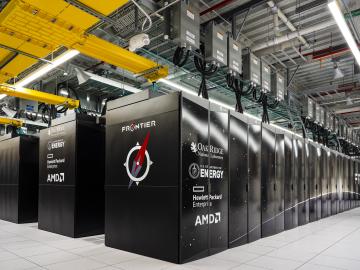
Filter News
Area of Research
News Type
News Topics
- (-) Artificial Intelligence (32)
- (-) Biomedical (9)
- (-) Computer Science (38)
- (-) Machine Learning (16)
- (-) Microscopy (8)
- (-) Security (5)
- 3-D Printing/Advanced Manufacturing (24)
- Advanced Reactors (4)
- Big Data (11)
- Bioenergy (23)
- Biology (23)
- Biotechnology (5)
- Buildings (9)
- Chemical Sciences (18)
- Clean Water (8)
- Composites (5)
- Coronavirus (3)
- Critical Materials (2)
- Cybersecurity (13)
- Education (3)
- Emergency (1)
- Energy Storage (18)
- Environment (48)
- Exascale Computing (16)
- Fossil Energy (2)
- Frontier (19)
- Fusion (11)
- Grid (15)
- High-Performance Computing (31)
- Hydropower (2)
- Isotopes (10)
- Materials (49)
- Materials Science (22)
- Mathematics (2)
- Mercury (2)
- Microelectronics (2)
- Molten Salt (1)
- Nanotechnology (9)
- National Security (19)
- Neutron Science (40)
- Nuclear Energy (25)
- Partnerships (24)
- Physics (17)
- Polymers (3)
- Quantum Computing (9)
- Quantum Science (14)
- Simulation (26)
- Software (1)
- Space Exploration (5)
- Summit (16)
- Transportation (14)
Media Contacts


Scientist-inventors from ORNL will present seven new technologies during the Technology Innovation Showcase on Friday, July 14, from 8 a.m.–4 p.m. at the Joint Institute for Computational Sciences on ORNL’s campus.

To support the development of a revolutionary new open fan engine architecture for the future of flight, GE Aerospace has run simulations using the world’s fastest supercomputer capable of crunching data in excess of exascale speed, or more than a quintillion calculations per second.

Innovations in artificial intelligence are rapidly shaping our world, from virtual assistants and chatbots to self-driving cars and automated manufacturing.

Like most scientists, Chengping Chai is not content with the surface of things: He wants to probe beyond to learn what’s really going on. But in his case, he is literally building a map of the world beneath, using seismic and acoustic data that reveal when and where the earth moves.

An innovative and sustainable chemistry developed at ORNL for capturing carbon dioxide has been licensed to Holocene, a Knoxville-based startup focused on designing and building plants that remove carbon dioxide

When reading the novel Jurassic Park as a teenager, Jerry Parks found the passages about gene sequencing and supercomputers fascinating, but never imagined he might someday pursue such futuristic-sounding science.

A study led by researchers at ORNL could uncover new ways to produce more powerful, longer-lasting batteries and memory devices.

Nature-based solutions are an effective tool to combat climate change triggered by rising carbon emissions, whether it’s by clearing the skies with bio-based aviation fuels or boosting natural carbon sinks.

As renewable sources of energy such as wind and sun power are being increasingly added to the country’s electrical grid, old-fashioned nuclear energy is also being primed for a resurgence.


